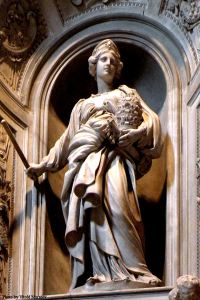Matilda of Tuscany (1046—July 1115 CE) was the daughter of Boniface III of Tuscany and Beatrice of Bar, who was the niece of the Holy Roman Emperor Conrad II. Her father held many territories, including the counties of Reggio, Modena, Mantua, Brescia, and Ferrara. She was most likely born in Lucca, Tuscany, as she was fluent in German. Matilda had at least one older sibling, but he predeceased Matilda and Beatrice of Bar. In 1052, Matilda’s father was assassinated, leaving her as the heir of his territories. As Matilda was still quite young, her mother married Godfrey, Duke of Upper and Lower Lorraine in order to protect her daughter’s inheritance. The duke was an enemy of Henry III, the Holy Roman Emperor at the time. In 1055, Henry III took Beatrice and Matilda hostage, but released them later in 1056 when he and the Duke of Lower Lorraine had reconciled (the duchy of Upper Lorraine had been confiscated from him).
Matilda was properly educated as an Italian noblewoman. She was good with languages, the arts, and needlework. She was also probably trained in battle strategy and castle fortification so she could become to perfect noble wife during dangerous times. She was raised to be deeply devout and pious in the Roman Catholic faith. At around 1066, Pope Benedict X was deposed and excommunicated on grounds of corruption in his election. Matilda of Tuscany was present at the assembly that declared Benedict X as an enemy of the Catholic faith. The Holy Roman Emperor at the time, Henry IV, did not agree with Rome’s decision and supported Benedict X. He appointed a new Pope, Honorius II, and marched with his armies in order to depose the Pope that Rome had appointed. In 1066, Matilda was present at the Battle of Aquino against Henry IV and Honorius II. Rome was victorious, and kept Alexander II as Pope.
In 1069, Matilda’s stepfather Godfrey died. She married his son, Godfrey the Hunchback, and became Duchess of Lower Lorraine. They had one child together, but it died in infancy. Because of this, Matilda and Godfrey separated. Godfrey stayed in Lower Lorraine, and Matilda returned to Italy in order to co-rule Tuscany with her mother. In 1073, her childhood mentor Hildebrand, a monk, was elected Pope Gregory VII. Matilda supported him without question, allying herself and her plentiful army with Rome. Her husband, the Duke of Lower Lorraine, allied himself with the Holy Roman Emperor in response to the Pope’s suggested reforms. The Pope advocated for the end of the lay investiture which caused the “Investiture Conflict”.
In 1076, Matilda’s mother died and her husband was assassinated. Matilda became ruler of much of northern and central Italy, now having her husband’s lands as well as the lands she inherited from her father. During this year, Henry IV had publicly denounced the Pope, and Gregory VII had excommunicated the Holy Roman Emperor. Later, opinion turned against Henry IV, and he was forced to make amends. The mediation was seen by Matilda, his kinswoman.
The peace was not kept for long. Soon, Henry IV and Gregory VII were at odds again. The emperor invaded Italy, destroying much of Tuscany. Matilda refused to ally herself with Henry IV. In 1084, Matilda led her troops to attack the emperor’s, but to no avail. In 1087, Matilda supported the election of Pope Victor III, and she led her troops in order to put Victor in power. Rome failed again, and the Holy Roman Empire suppoted instead Pope Urban II, who looked to the reforms of Gregory VII.
In 1089, Matilda married Wulf of Bavaria, who was 17 (Matilda was in her forties), at the urging of the Pope. She allied herself with Henry IV wife, and Conrad of Lorraine, in order to defeat Henry IV. At first, the Holy Roman Emperor was victorious, and took much of Mantua. Later, he was defeated by Matilda and her army in Canossa. In 1095 she and Wulf separated when he allied himself with Henry IV. They warred until 1106, when Henry IV died. The new Holy Roman Emperor was Henry V, and this time they made efforts to reconcile. She willed some of her lands to Henry V, and he, in turn, made her regent of Italy.
Legacy: She was the most powerful and rich woman during her lifetime. Due to some redundancies in her will, there were many disputes over ownership of Tuscany. Finally it was decided that Tuscany belonged to the Catholic Church, and not to the Holy Roman Empire.
http://en.wikipedia.org/wiki/Matilda_of_Tuscany
http://en.wikipedia.org/wiki/Godfrey,_Duke_of_Upper_Lorraine
http://epistolae.ccnmtl.columbia.edu/woman/29.html
http://womenshistory.about.com/od/medievalitalianwomen/fl/Matilda-of-Tuscany.htm
http://atheism.about.com/library/glossary/western/bldef_investiture.htm

